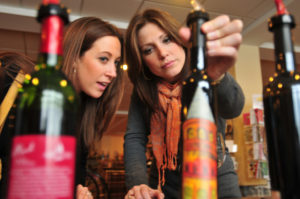Consumer wine preference is an oft-studied topic, as understanding wine preference is paramount in determining how to market and sell any given wine. It can also help wine marketers not only observe what consumers like, but also how these preferences can change over time and between different segments.
Often, wine preference is determined via the hedonistic scale, or how much a consumer says they like a particular style of wine. However, research in food and other industries have found

Photo courtesy Flickr user Visit Finger Lakes
that the role of emotions may provide an extra level of understanding in regard to consumer preferences and that this type of analysis may be very useful in wine as well. For example, studies have found many associations between certain flavor types and emotions in various foodstuffs: in dark chocolate, studies have linked “powerful” and “energetic” with cocoa flavor; and in beer, studies have linked herbal flavors with “sadness” and citrus flavors with “disappointment.
According to the authors of a new study, available online in late December 2017 and to be published in print in June 2018 in the journal Food Quality and Preference, there have been no studies linking specific wine sensory characteristics with emotional responses, nor is there a dedicated lexicon for such relationships in wine products like there are with food (i.e. the EsSense Profile). In this new study, the researchers aimed to analyze the associations between sensory characteristics of wine and elicited emotional responses of consumers, further subcategorized by gender and age.
Brief Methods
This study had two parts: a sensory evaluation of the wines by a trained panel (11 total: 5 women, 6 men; faculty and researchers from the School of Agricultural, Food and Biosystems Engineering at the Universidad Politécnica de Madrid in Spain), and a consumer evaluation of the wines with an additional emotional response analysis.
6 commercially-available wines were used in the study: 2 whites, 1 rosé, and 3 reds.
For the sensory evaluation by the trained panel, each wine was scored for various aromatic and sensory attributes using an unstructured 15-cm line scale that had labels “low” and “high” on the ends (with variation throughout the line that could be translated to a specific intensity level of any given attribute). Wines were presented in random order.

Photo courtesy Flickr user H. Michael Miley
For the consumer evaluation, participants were first asked to complete questionnaires on demographics and wine consumption habits. Next, they participated in a “warm-up” or “practice” tasting session with 7 wines presented [blind] at the same time. Finally, after the warm-up, they were presented with the sample of 6 test wines briefly mentioned above.
After tasting the wines (which were presented in random order), participants were asked to rate their liking of each wine (using a 9-point hedonic scale), and what emotions were elicited by each wine (using the EsSense 25 software). Emotions were rated using a 10-cm line scale with the labels “very low” and “very high” at the ends (and everything in between).
Participants were recruited from the School of Agricultural, Food and Biosystems Engineering at the Universidad Politécnica de Madrid and were required to consume wine at least once per month. A total of 208 people participated in the study (48.5% male, 51.5% female). Participants were categorized by three age groups (for studying potential age effects): young adults (18-35 years old; 44.9% of the total); middle-aged adults (36-55 years old; 29.3% of the total); and older adults (55 years old and older; 25.9% of the total).
Selected Results
- Most of the emotion terms evaluated were found to be significantly different between the wines.
- Only 4 out of 26 terms did not show significant association with the wines (“adventurous”, “free”, “wild”, and “worried”).
- The emotion terms “good”, “happy”, “joyful”, “mild”, and “pleasant”, were positively associated with fruity and floral aromas/flavors in the wines.
- The emotion terms “aggressive” and “guilty” were associated with the aromas/flavors of vanilla, clove, and licorice.
- “Aggressive” was also found to be associated with astringent characteristics.
- Using cluster analysis, wines were found to be grouped differently when looking at sensory characteristics alone versus when looking at emotional variables alone. (NOTE: cluster analysis shows which wines are most similar to each other.)
- Sensory analysis grouped the wines as: 1) the verdejo white in one group; 2) the chardonnay and rosé wine in another group; 3) a Rioja Tempranillo (2012) and a Ribera del Duero Tempranillo in another group; and 4) a different Rioja Tempranillo (2013) in the last group.
- Emotion analysis grouped the wines as: 1) the verdejo and chardonnay wines in one group; 2) the rose wine in another group; 3) the two Rioja Tempranillos (2012, 2013) in another group; and 4) the Ribera del Duero Tempranillo in the last group.
Gender Analysis
- For those emotion terms that were significant, men scored the emotions higher than women.
- Wines that conjured up “bored” emotions for men did not do so for women.
- The emotions “mild” and “tame” were the only two emotions that were comparable between men and women in terms of their scores.
- Women scored “joyful” higher in white wines than red wines (no difference for men).
- Using the cluster analysis, this time separated by gender, wines were found to be grouped differently between men and women.
- For men: 1) the chardonnay and the rose wines were grouped together; 2) the verdejo was in another group by itself; 3) the two Rioja Tempranillos were in another group; and 4) the Ribera del Duero Tempranillo was in the last group by itself.
- For women: 1) the two white wines were grouped together; 2) the rosé wine was in another group by itself; 3) the 2012 Rioja Tempranillo and the Ribera del Duero Tempranillo was in another group; and 4) the 2013 Rioja Tempranillo was in the last group by itself.
Age Analysis
- Older adults scored emotion terms higher than their younger counterparts (including the terms “active”, “enthusiastic”, “good natured”, “joyful”, “loving”, “mild”, “nostalgic”, “pleasant”, “satisfied”, “understanding”, “warm”, “happy”, “calm”, “good”, and “curious”).
- Negative terms like “guilty” and “worried” scored higher in younger adults than their older counterparts.
- For young adults, the two white wines and the rosé scored higher for the emotions “good”, “happy”, and “pleasant”, while these terms scored the lowest for the 2013 Rioja Tempranillo.
- For older adults, the emotion “mild” was the term that showed the biggest difference between the whites/rosé and the 2013 Rioja Tempranillo.
- Young adults felt less “guilty” of consuming any of the wines than their older counterparts.
Conclusions
Overall, this study showed that certain emotions are associated with different types of wines, and these emotions varying between genders, ages, and the type of wine consumed. Out of 26 different emotions of focus in this study, only 4 were found to be insignificant (“adventurous”, “free”, “wild”, and “worried”), providing evidence that emotions are important

Photo courtesy Flickr user Luca Sartoni
in the overall enjoyment of a wine and thus preference. If a wine conjures up negative emotions for an individual, that person is probably not going to buy that bottle of wine in the future. Of course, willingness-to-pay or probability-of-purchase was not included in this study, but I would imagine that someone wouldn’t be very likely to buy a bottle of wine that fills them with negative emotions.
In terms of relationships between emotions and specific wine styles, the study found that white wine characteristics were often associated with more positive emotions, while aged wine characteristics were associated more often with negative emotions. I don’t have much of a comment on this finding, except for the fact that it is a very interesting one and that it might help wine educators or markets tailor their agendas/campaigns to develop different approaches to improve the emotional associations tied to aged red wine characteristics.
For gender, men tended to score emotions higher than women, and in terms of age, older adults tended to score emotions higher than their younger counterparts.
The cluster analyses were also very fascinating, in that they showed wines were not always grouped together the same when looking at the sensory characteristics separate from the emotional associations. While sensory analysis might group wine A and wine B together and then wine C and wine D together, the emotional analysis might group them differently. In other words, two wines might taste similar enough to one another than they end up in the same group, however, the emotions elicited from these wines might be different enough to split them apart and put them in an entirely different group.
(Additionally, rose wine was typically seen as more similar to white wines than reds in terms of both sensory and emotional responses.)
We see this in the first cluster analysis where the sensory analysis put the chardonnay and rosé together in one group, and the verdejo in another group, while the emotion analysis put the two white wines together in one group leaving the rose for a separate group. Same thing with the red wines—sensory analysis put the two 2012 tempranillos together in one group and the 2013 tempranillo in another, while the emotional analysis put the two Rioja tempranillos (the 2012 and 2013) in one group, while putting the 2012 Ribera del Duero tempranillo in a group by itself. This shows that in our minds, we group things differently by taste than we do by emotion. This finding, in a way, makes things more difficult for wine educators and marketers, as there is now an added level of complexity to think about when trying to reach your target consumer audience.
This study, while interesting, does have its limitations: 1) it’s limited to a relatively small number of consumers in Spain and 2) it only looked at 6 different wines, which hardly represents the wide diversity of wines on the market today. I would also have liked to see a comparison to consumers willingness to pay for a given wine, which could have been as easy as another short questionnaire (or even just a couple of questions).
Overall, a fascinating look at emotions and wine, with many questions remaining and hopefully addressed in the future.
Source:
